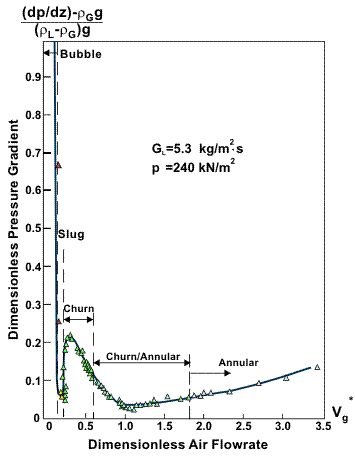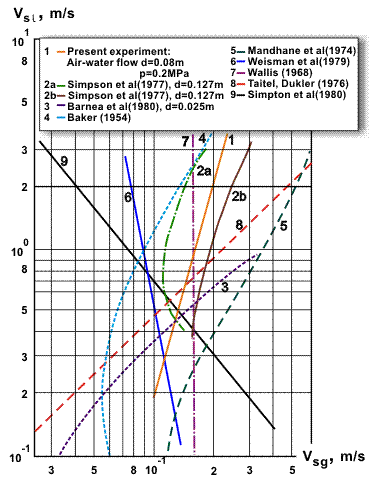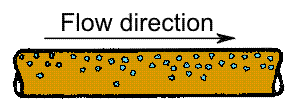Of the four type of Two-Phase Flow (Gas-Liquid, Gas-Solid, Liquid-Liquid and Liquid-Solid), gas-liquid flows are the most complex, since they combine the characteristics of a deformable interface and the compressibility of one of the phases. For given flows of the two phases in a given channel, the gas-liquid interfacial distribution can take any of an infinite number of possible forms. However, these forms can be classified into types of interfacial distribution, commonly called flow regimes or flow patterns. Detailed discussions of these patterns are given by Hewitt (1982), Whalley (1987) and Dukler and Taitel (1986). The regimes encountered in vertical flows are illustrated in Figure 1. They include Bubble Flow, where the liquid is continuous, and there is a dispersion of bubbles within the liquid; Slug or Plug Flow where the bubbles have coalesced to make larger bubbles which approach the diameter of the tube; Churn Flow where the slug flow bubbles have broken down to give oscillating churn regime; Annular Flow where the liquid flows on the wall of the tube as a film (with some liquid entrained in the core) and the gas flows in the centre; and Wispy Annular Flow where, as the liquid flow rate is increased, the concentration of drops in the gas core increases, leading to the formation of large lumps or streaks (wisps) of liquid.
Figure 1.
Flow patterns in vertical flow (All Flows  ).
).
Flow regimes in horizontal flow are illustrated in Figure 2. Here, as gravity acts normally to flow direction, separation of the flow occurs. The respective flow regimes are Stratified Flow, where the gravitational separation is complete; stratified-wavy flow; Bubble Flow, where the bubbles are dispersed in the liquid continuum (though there is some separation due to gravity as illustrated); annular dispersed flow, which is similar to that in vertical flow, though there is asymmetry in the film thickness due to the action of gravity; and a variety of intermittent flows. This latter category includes Plug Flow, in which there are large bubbles flowing near the top of the tube; semi-slug flow, where very large waves are present on the stratified layer; and Slug Flow, where these waves touch the top of the tube and form a liquid slug which passes rapidly along the channel. Pipe inclination is an important parameter in determining flow regimes, and flows in inclined pipes and in other geometries are discussed by Hewitt (1982). It is necessary to predict regimes as a basis for carrying out calculations on two-phase flow, and the usual procedure is to plot the information in terms of a flow regime map. Many of these maps are plotted in terms of primary variables (superficial velocity of the phases or mass flux and quantity, for instance), but there has been a great deal of work aimed at generalising the plots, so that they can be applied to a wide range of channel geometries and physical properties of the fluids. A generalised map for vertical flows is shown in Figure 3 and is due to Hewitt and Roberts (1969) (see Hewitt, 1982).
This map is plotted in terms of the superficial momentum fluxes of the two phases ?LUL2 and ?GUG2. A generalised flow pattern map for horizontal flow is that of Taitel and Dukler (1976) (see Dukler and Taitel, 1986), and is illustrated in Figure 4. This is plotted in terms of the following parameters:




where (dpF/dz)L and (dpF/dz)G are the pressure gradients for the liquid phase and gas phase respectively, flowing alone in the channel, ?L and ?G are the phase densities, UL and UG are the superficial velocities of the phases, D the tube diameter, ?L the liquid kinematic viscosity, g the acceleration due to gravity, and ? the angle of inclination of the channel.
Figure 3. Flow pattern map obtained by Hewitt and Roberts (1969) for vertical two-phase co-current upwards flow in a vertical tube.
Figure 4. Flow pattern map for horizontal co-current flow obtained by Taitel and Dukler (1976). (See Dukler and Taitel, 1986).
Taitel et al. (1980) also produced a flow pattern map for vertical flow, but this has met with less widespread use. Following similar approaches, Barnea (1987) has produced a unified model for flow pattern transitions for the whole range of pipe inclinations.
The most important transitions are as follows:
Bubble-Plug transition. It has been traditional to regards this transition to occur as a result of bubble coalescence leading to gradual bubble growth and the formation of large Taylor-type bubbles which occupy the whole pipe cross-section. Typically, the transition to slug flow occurs when the void fraction is around 25-30%. In highly turbulent flows, break-up of the bubbles may be postulated to occur (through this is rarely seen in actual bubble flows) to offset the progression of the coalescence. However, recent information seems to indicate that this view of the transition may be quite wrong. It seems more likely that void waves are formed in the flow, and that, within these waves, the bubbles become closely packed and are better able to coalesce, leading to plug flow. Evidence for this is provided, for instance, by Beisheuvel and Gorissen (1990).
Plug-annular flow transition. This has been an area of major controversy. Probably the main difficulty has been a semantic one. Taitel et al. (1980) define a "churn flow" which is essentially a developing plug or slug flow. However, churn flow as defined here does exist in fully developed flow, and has the following unique characteristics:
The regime is entered from slug flow by the formation of flooding-type waves (see Flooding and Flow Reversal), and these persist as a characteristic of the regime throughout. Such waves are absent in both slug flow and annular flow but are formed repeatedly in the churn flow regime and transport the liquid upwards (Hewitt et al. 1985 and Govan et al. 1990).
In between successive flooding waves, the flow of the liquid phase in the film region near the wall reverses direction, and is eventually entrained by the next upward-moving wave.
The onset of churn flow is accompanied by a sharp increase in pressure gradient, as is illustrated by the results obtained by Owen (1986) and illustrated in Figure 5. A detailed evaluation of the plug to churn flow transition in terms of this flooding mechanism is given by Jayanti and Hewitt (1992).
Churn to annular flow transition. As the gas velocity is increased after the churn flow regime has been entered, the pressure gradient initially decreases and the passes through a minimum value (see Figure 5). The flooding waves (and their associated intensive gas-liquid interactions promote large pressure gradients, and as they disappear, the pressure gradient reduces.

Figure 5. Data for pressure gradient in fully developed air-water flux in a vertical tube (Owen, 1986).
Eventually, however, the pressure gradient increases again as the gas flow rate increases. Properly speaking, one might define the onset of true annular flow as that corresponding to the point as which there is no flow reversal within the liquid film. This might correspond approximately to the pressure drop minimum (though not accurately so). Another definition might be the flow reversal point (see Flooding and Flow Reversal). It is clear that, though both churn and annular flow have the characteristic of having a liquid layer at the wall and a gas core in the centre of the pipe, their flow behaviour is quite different. The definition of the exact point of transition is, nevertheless, quite difficult.
Annular to wispy-annular transition. This is supposed to occur approximately at a critical liquid momentum flux (see Figure 3) though, again, identification of the transition is to some extent subjective.
Again, there has been an intensive interest in flow pattern transitions for flow in horizontal pipes, mainly arising out of the importance of such phenomena in the offshore pipeline area. A commentary on some of the important transitions in such flows is as follows:
Stratified-slug transition. The Taitel and Ducker (1976) model ascribed this transition to the onset of Kelvin-Helmholz instability and applied an inviscid form of this instability to the prediction of the transition. However, it was found this did not agree well with the actual transition and it was necessary to introduce an arbitrary correction function to bring the data into line with the predictions. A closer approximation is presented in the analysis of Lin and Hanratty (1986) who present a theory taking account of viscous effects. However, the prediction of this transition still remains an area of uncertainty.
Slug-annular transition. In the Taitel and Dukler (1976) model, this transition was assumed to occur if the equilibrium liquid level at the onset of the Kelvin-Helmholz instability was less than half the channel diameter. However, this does not appear to fit the transition well, nor are there any generally satisfactory models. Figure 6 shows a comparison of the model predictions from various approaches and it will be seen that there is not only a discrepancy between these in magnitude, but also in trend!
Slug-dispersed bubble transition. In the Taitel and Dukler and related maps, this transition is ascribed to the capability of the turbulence in the liquid phase to suspend the bubbles. When the bubbles cannot be suspended, then they agglomerate to form the gas bubble regions in slug flow. In actual fact, however, the mechanisms of bubble entrainment and behaviour in slug flow are extremely complex and need much further investigation.

Figure 6. Comparision of relationships for slug/annular transition in horizontal flow data of Reiman.
REFERENCES
Barnea, D. (1987) A unified model for predicting flow-pattern transitions for the whole range of pipe inclinations, Int. J. Multiphase Flow, 13, 1-12. DOI: 10.1016/0301-9322(87)90002-4
Biesheuvel, A. and Gorissen, W. C. M. (1990) Void fraction disturbances in a uniform bubbly fluid, Int. J. Multiphase Flow, 16, 211-231. DOI: 10.1016/0301-9322(90)90055-N
Dukler, A. E. and Taitel, W. (1986) Flow Pattern Transitions in Gas-Liquid Systems: Measurement and Modelling, Chapter 1 of Multiphase Science and Technology, Vol. 2 (Ed. G. F. Hewitt, J. M. Delhaye and N. Zuber), Hemisphere Publishing Corporation.
Govan, A. H., Hewitt, G. F., Richter, H. J. and Scott, A. (1991) Flooding and churn flow in vertical pipes, Int. J. Multiphase Flow, 17, 27-44. DOI: 10.1016/0301-9322(91)90068-E
Hewitt, G. F. (1982) Chapter 2, Handbook of Multiphase Systems (Ed. G. Hetsroni), Hemisphere Publishing Corporation, New York.
Hewitt, G. F., Martin, C. J. and Wilkes, N. S. (1985) Experimental and modelling studies of annular flow in the region between flow reversal and the pressure drop minimum, Physico-Chemical Hydrodynamics, 6, 43-50.
Lin, P. Y. and Hanratty, T. J. (1986) Prediction of the initiation of slugs with linear stability theory, Int. J. Multiphase Flow, 12, 79-98. DOI: 10.1016/0301-9322(86)90005-4
Taitel, Y., Barnea, D. and Dukler, A. E. (1980) Modelling flow pattern transitions for steady upward gas-liquid flow in vertical tubes, AIChE J, 26, 345-354.
Whalley, P. B. (1987) Boiling and Condensation and Gas-Liquid Flow, Clarendon Press, Oxford.
References
- Barnea, D. (1987) A unified model for predicting flow-pattern transitions for the whole range of pipe inclinations, Int. J. Multiphase Flow, 13, 1-12. DOI: 10.1016/0301-9322(87)90002-4
- Biesheuvel, A. and Gorissen, W. C. M. (1990) Void fraction disturbances in a uniform bubbly fluid, Int. J. Multiphase Flow, 16, 211-231. DOI: 10.1016/0301-9322(90)90055-N
- Dukler, A. E. and Taitel, W. (1986) Flow Pattern Transitions in Gas-Liquid Systems: Measurement and Modelling, Chapter 1 of Multiphase Science and Technology, Vol. 2 (Ed. G. F. Hewitt, J. M. Delhaye and N. Zuber), Hemisphere Publishing Corporation.
- Govan, A. H., Hewitt, G. F., Richter, H. J. and Scott, A. (1991) Flooding and churn flow in vertical pipes, Int. J. Multiphase Flow, 17, 27-44. DOI: 10.1016/0301-9322(91)90068-E
- Hewitt, G. F. (1982) Chapter 2, Handbook of Multiphase Systems (Ed. G. Hetsroni), Hemisphere Publishing Corporation, New York.
- Hewitt, G. F., Martin, C. J. and Wilkes, N. S. (1985) Experimental and modelling studies of annular flow in the region between flow reversal and the pressure drop minimum, Physico-Chemical Hydrodynamics, 6, 43-50.
- Lin, P. Y. and Hanratty, T. J. (1986) Prediction of the initiation of slugs with linear stability theory, Int. J. Multiphase Flow, 12, 79-98. DOI: 10.1016/0301-9322(86)90005-4
- Taitel, Y., Barnea, D. and Dukler, A. E. (1980) Modelling flow pattern transitions for steady upward gas-liquid flow in vertical tubes, AIChE J, 26, 345-354. DOI: 10.1002/aic.690260304
- Whalley, P. B. (1987) Boiling and Condensation and Gas-Liquid Flow, Clarendon Press, Oxford. DOI: 10.1017/S0022112088211739











